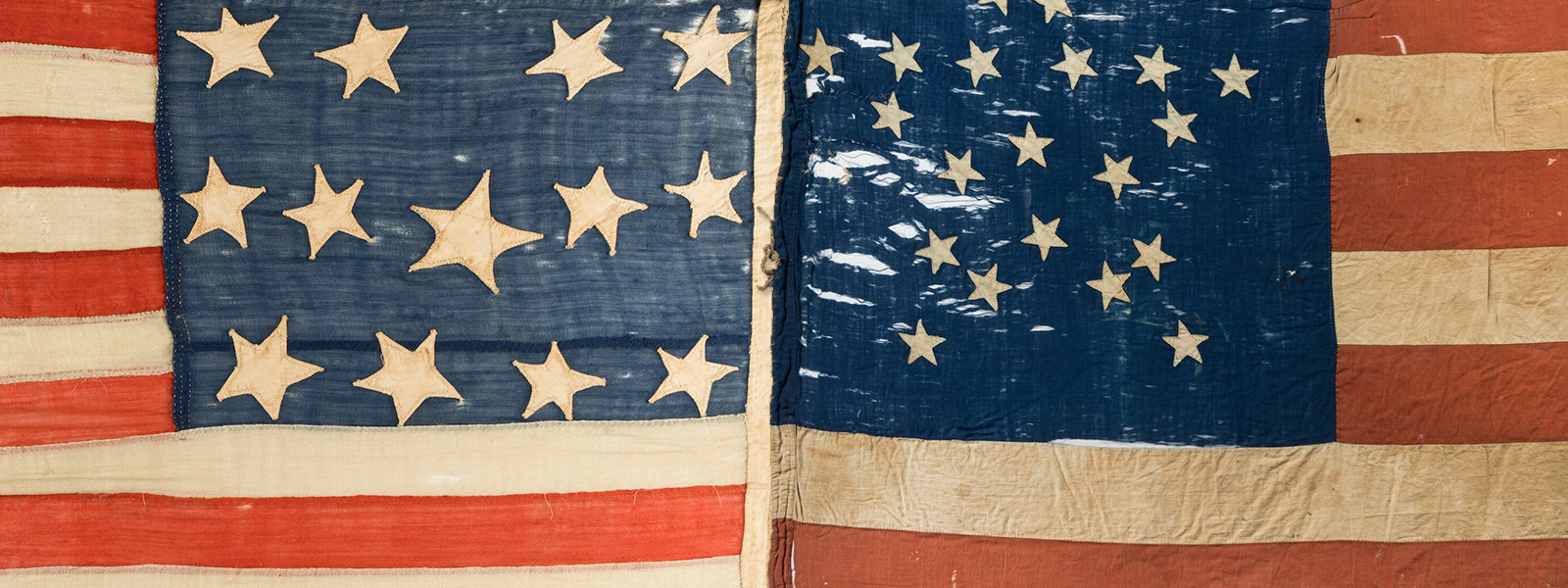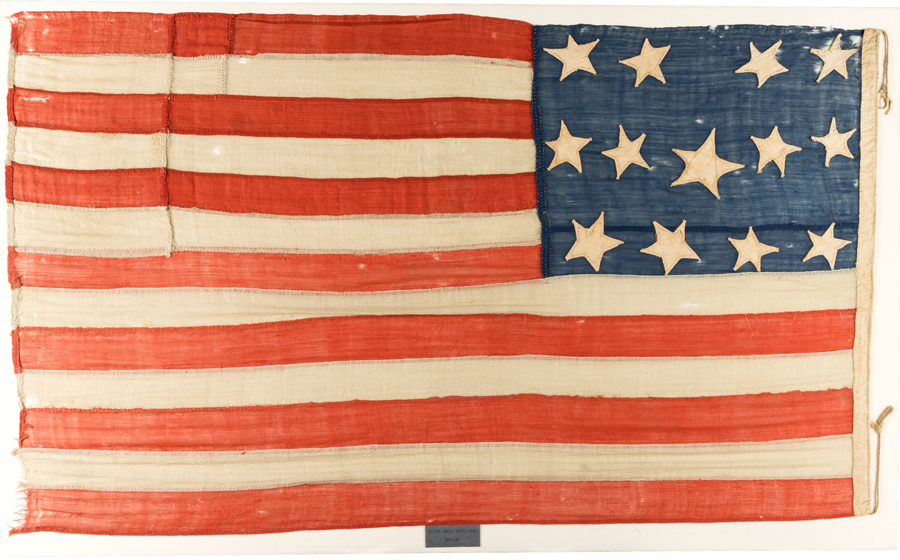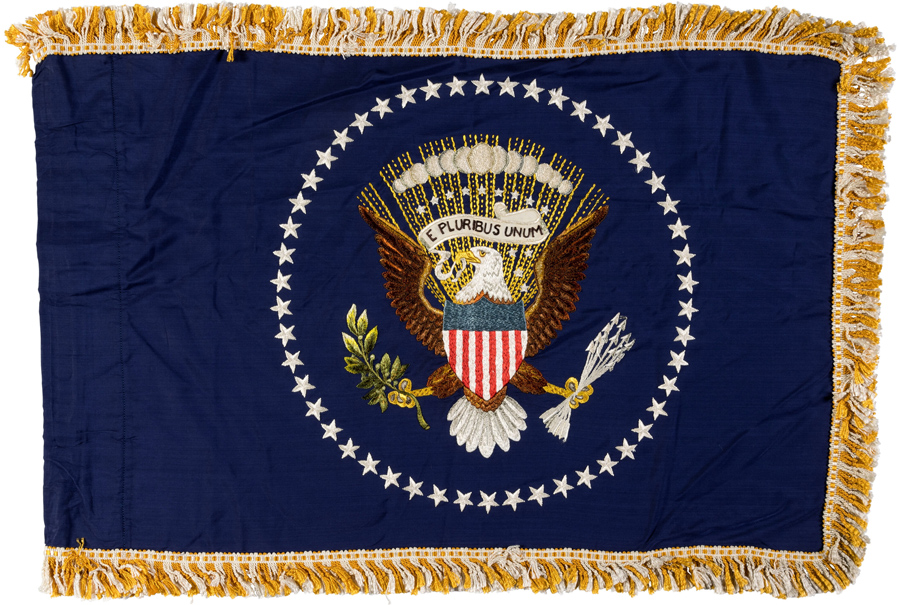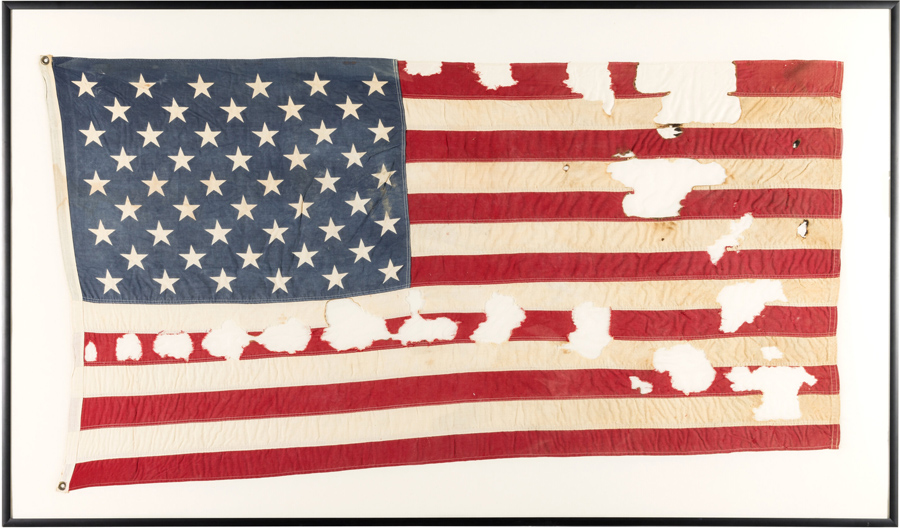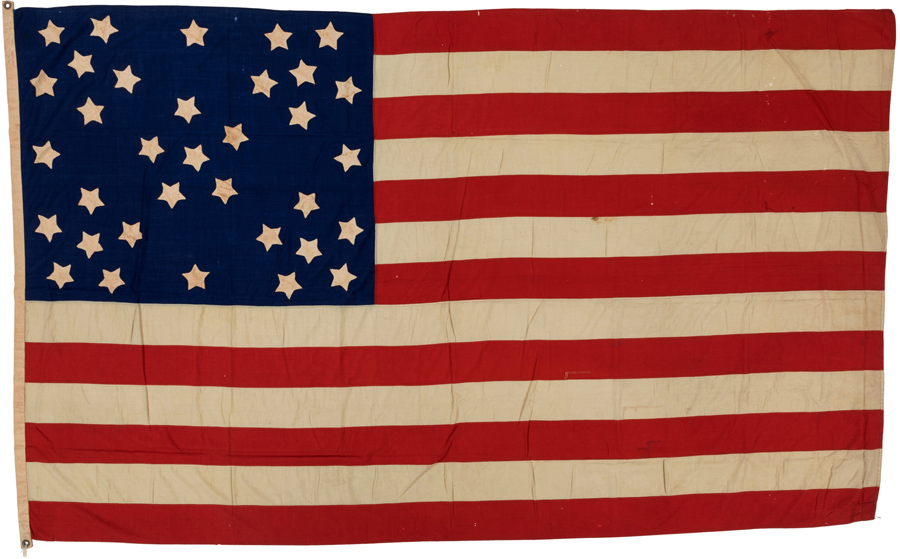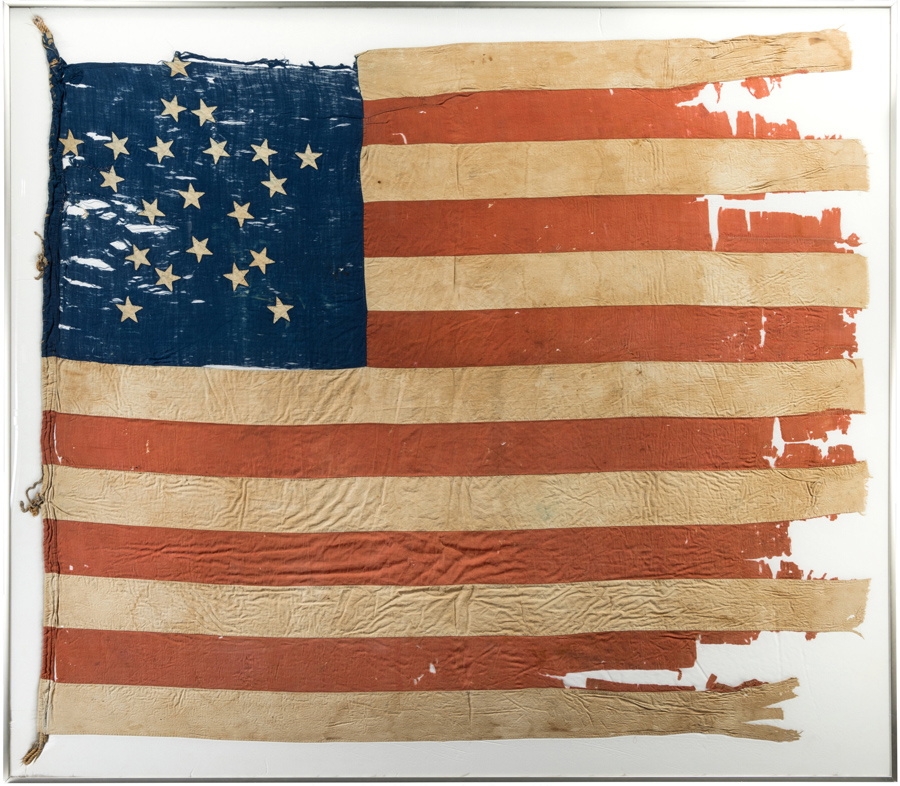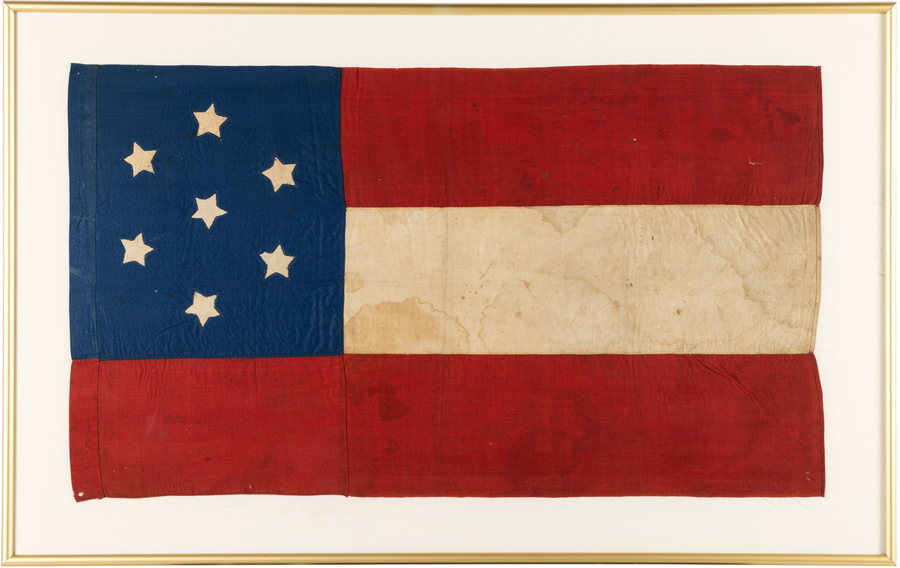THE CELEBRATED ZARICOR FLAG COLLECTION INCLUDES FLAGS FROM THE WORLD TRADE CENTER, JFK’S PRESIDENTIAL LIMOUSINE AND STAR-SPANGLED BANNERS FROM THE NATION’S EARLIEST DAYS
By Robert Wilonsky
In 1969, as a senior at St. Louis’ Washington University, Ben Zaricor thought about the American flag as much as any other kid who’d memorized the Pledge of Allegiance and The Star-Spangled Banner. Which is to say, not all that much. But as the Tennessee native would often recount, Zaricor’s perception of the flag and its potency as a symbol dramatically changed one afternoon while he ate at a pizzeria near campus.
When asked how he came to amass one of the world’s largest and most significant collections of American flags, Zaricor always began with the story of a young man snatched from his seat, taken outside that restaurant and beaten simply for wearing a vest emblazoned with the Stars and Stripes.
“This led to a small riot in front of the restaurant, with several people, including myself, trying to help the young man,” Zaricor once said during an interview with the Smithsonian’s National Portrait Gallery. “We were then attacked by a total of 15 men. Guns were shown by the attackers, and a full-scale riot was averted by the arrival of the uniformed police.
“That experience gave me pause about the power of symbols. I was intrigued by a symbol that people would not only die for but would also kill for. From there, I began collecting flags, in part out of curiosity and in part as a form of protest of what happened to the young man.”
The first two flags in his collection were Canadian; then came the American flags and associated artifacts, their number escalating into the dozens, then the hundreds, then the thousands – nearly 4,000, all told. Among their ranks are some of the earliest flags flown in the fledgling union, flags that accompanied presidents in motorcades and astronauts to the moon, flags made to represent milestone moments in the nation’s history. In time, they would come to be known as the Zaricor Flag Collection, which “collectively tell the American story,” as the Robb Report noted in 2014.
AMERICANA & POLITICAL SIGNATURE® AUCTION 6276
November 13-14, 2023
Online: HA.com/6276
INQUIRIES
Tom Slater
214.409.1441
TomS@HA.com
Thirty-two flags from the vaunted, oft-displayed Zaricor Flag Collection are available in Heritage’s latest Americana & Political Signature® Auction, which takes place November 13-14. Each is what Zaricor, who founded the Good Earth Tea Company and died last year at 74, liked to call a “silent witness” to history, and all come with lengthy exhibition and publication histories.
That includes one of the most significant flags Heritage has ever offered: a 13-star U.S. flag with the four-five-four star pattern, coveted among collectors as few flags from the Union’s earliest days survive and only a small handful reside in private collections. What makes this heavy cotton flag even more significant is its provenance: It hails from the Old Sandy Point Lighthouse in New York, dates to the early 1790s, and was flown under the authority of the Department of the Treasury’s Lighthouse Establishment, among the federal government’s first agencies.
Just as scarce is this John F. Kennedy Presidential Automobile Flag with Presidential Arms, which Zaricor acquired from the collection of David Powers, a close friend of Kennedy’s who served as his special assistant and, later, as curator of the John F. Kennedy Presidential Library and Museum. This embroidered Bemberg flag is among the few Presidential Automobile flags documented to the Kennedy Administration and is believed to have been the flag used during the Fort Worth portion of Kennedy’s trip to Texas in November 1963.
Zaricor believed the flags that adorned Kennedy’s limousines represented his openness as president, his desire to seem accessible to the American public. Says flags scholar and author Dr. Whitney Smith Jr., they were the hallmarks of a man who “wanted to be seen, get out, shake hands.” They were more than mere testaments to tragedy.
Which isn’t to say the Zaricor Flag Collection isn’t rife with flags from some of this country’s darkest moments, among them one of only a handful of flags recovered from the ruins of the World Trade Center following the terror attacks of September 11, 2001.
This one was discovered by David Bliss, a volunteer fireman from Ohio, during the recovery phase. While sifting through what little remained of the South Tower, Bliss noticed what he thought were fragments of a victim’s clothing. But as he continued to dig, Bliss realized he’d found the smoldering remains of a flag that had likely decorated one of the tower’s offices. It was eventually displayed at Disney’s Epcot Center in 2002 and San Francisco’s The Presidio the following year as part of the exhibition “The American Flag: Two Centuries of Concord and Conflict.” Zaricor acquired the flag in ’03.
The expanse of the Zaricor Flag Collection is on full display even among this relatively small selection of offerings.
Here, for instance, is the 34-star flag from the 1860s, otherwise known as the “Snowflakes Flag,” which, like so many flags from the collection, spent decades being exhibited across the country – including, twice, in the World Trade Center and on the cover of Time on July 7, 1980, for its “Rediscovering America” issue. This 69-by-113-inch wool flag looks like none other with its five clusters of six stars each and the single stars along the edge of the canton. Its interpretations are myriad; its origin a relative mystery, save for the fact it was in the possession of one of this country’s first and finest flag collectors and remains, as the catalog notes, “one of the most interesting 34-star flags in existence from the tumultuous period of the American Civil War.”
Zaricor was particularly enamored of such flags, as they revealed the long-held tradition of Americans creating their own designs beholden to no one. As he wrote in 2003, “because no single group ‘owns’ the flag, or ever has, its design and the materials it is fashioned from illustrate the creativity, whimsy and idiosyncratic realities that are embedded in our singular culture.”
That describes the tattered 21-star “Grand Luminary” flag used only for the year following Illinois’ admission to the Union in 1818; the 26-star flag made upon the admission of Michigan as a state in 1837, its star field a strange pattern that includes two stars on the fly end of the canton; and the decidedly scarce 32-star flag (created to mark Minnesota’s admission to the Union in 1858) converted to a 34-star flag to meet the demand sparked by the outbreak of the Civil War in April 1861.
Here, too, is a handmade 36-star “Grand Luminary” flag with a black border that flew in Providence, Rhode Island, following the assassination of President Abraham Lincoln in April 1865. This historic silk bears all the hallmarks of a Zaricor-collected flag: It was once part of another storied collection (that of antiques dealer Boleslaw Mastai and his wife, Marie-Louise d’Otrange Mastai) and appeared in several books, among them the couple’s landmark The Stars and the Stripes: The American Flag as Art and as History from the Birth of the Republic to the Present, the first history to thoroughly document the United States flag in its various incarnations.
Each offering in this historic auction – which Zaricor Flag Collection curator James Ferrigan likes to say overflows with “old friends” – offers a tome’s worth of tales, from the 7-star Confederate 1st National Camp Flag that was once part of the Star-Spangled Banner Flag House Museum’s collection to the Republic of Hawaii flag from the late 1800s that flew over the consul general in Chicago to the green-striped Ecology flag made by the Paramount Flag Company in the late 1960s. There is a narrative woven into the fabric of each flag; these are our few remaining tangible connections to the yesterdays that define today.
 ROBERT WILONSKY is a staff writer at Intelligent Collector.
ROBERT WILONSKY is a staff writer at Intelligent Collector.

